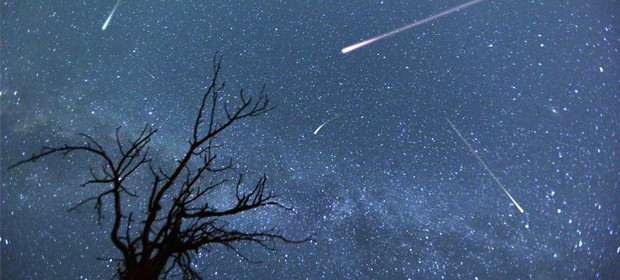One of the year’s best-known and most reliable annual displays of “shooting stars” is the famed Perseid Meteor Shower which peaks every August. But so often the presence of the Moon in the sky interferes with its visibility, as is the case again this year. And while its peak activity will be compromised by moonlight, with proper planning you can still enjoy at least some of this display.
The Perseids are at maximum activity this year on the night of August 11th to 12th. Under dark sky conditions observers can expect to see about 100 meteors an hour (more than one a minute!), with the actual peak expected sometime in the early morning hours. Unfortunately, this date falls between Full Moon on the 7th and Last Quarter on the 14th.
The only time the shower is an actual “washout” is if the peak occurs on the night of the full Moon itself, which rises at sunset and stays in the sky until sunrise. But nights on either side of this time offer opportunities to still see meteors, even if reduced in number.
One way is to observe the shower soon after darkness falls and before the Moon rises, which will be somewhere between 10 p.m. and 11 p.m. local time depending on your latitude. The meteors will be radiating from the constellation Perseus, which will just be clearing the northeastern horizon abound 9 p.m. local time. Use your Scientifics Star & Planet Locator set for that time to identify it. As Perseus climbs higher in the sky, the number of meteors seen will increase until the Moon itself rises. Which brings us to a second opportunity for seeing them—this time in the moonlight!
While the presence of the Moon will mask most of the fainter shower members, the brighter meteors will still be visible in the moonlight. And more of them the later into the evening you watch for two reasons. First, Perseus climbs ever-higher in the sky, bringing the source of the meteors (the radiant) more fully into view. Secondly, after midnight, our spinning Earth is turned more and more into the direction they are coming from, adding its speed of rotation to their velocity. This results in their number not only increasing but their brightness as well since they are hitting the atmosphere at higher speed. This also enhances the chances of seeing a bright fireball or bolide. So don’t quit observing simply because the Moon has made its appearance! And as always when meteor observing, it’s best to recline in a lawnchair both for comfort and for a better overall view of the sky. Finally, one other thing that will be helpful here—face away from the Moon itself (or better yet hide it behind a house) to maintain some level of dark adaptation.
Before closing, just a reminder about the total eclipse of the Sun this month on the afternoon of Monday, the 21st! Be sure to see the May and June Sky Talk installments for complete details on this spectacular not-to-be-missed event.
—James Mullaney
Former assistant editor at Sky & Telescope magazine & author of nine books on stargazing. His latest, Celebrating the Universe!, is available from HayHouse.com.


